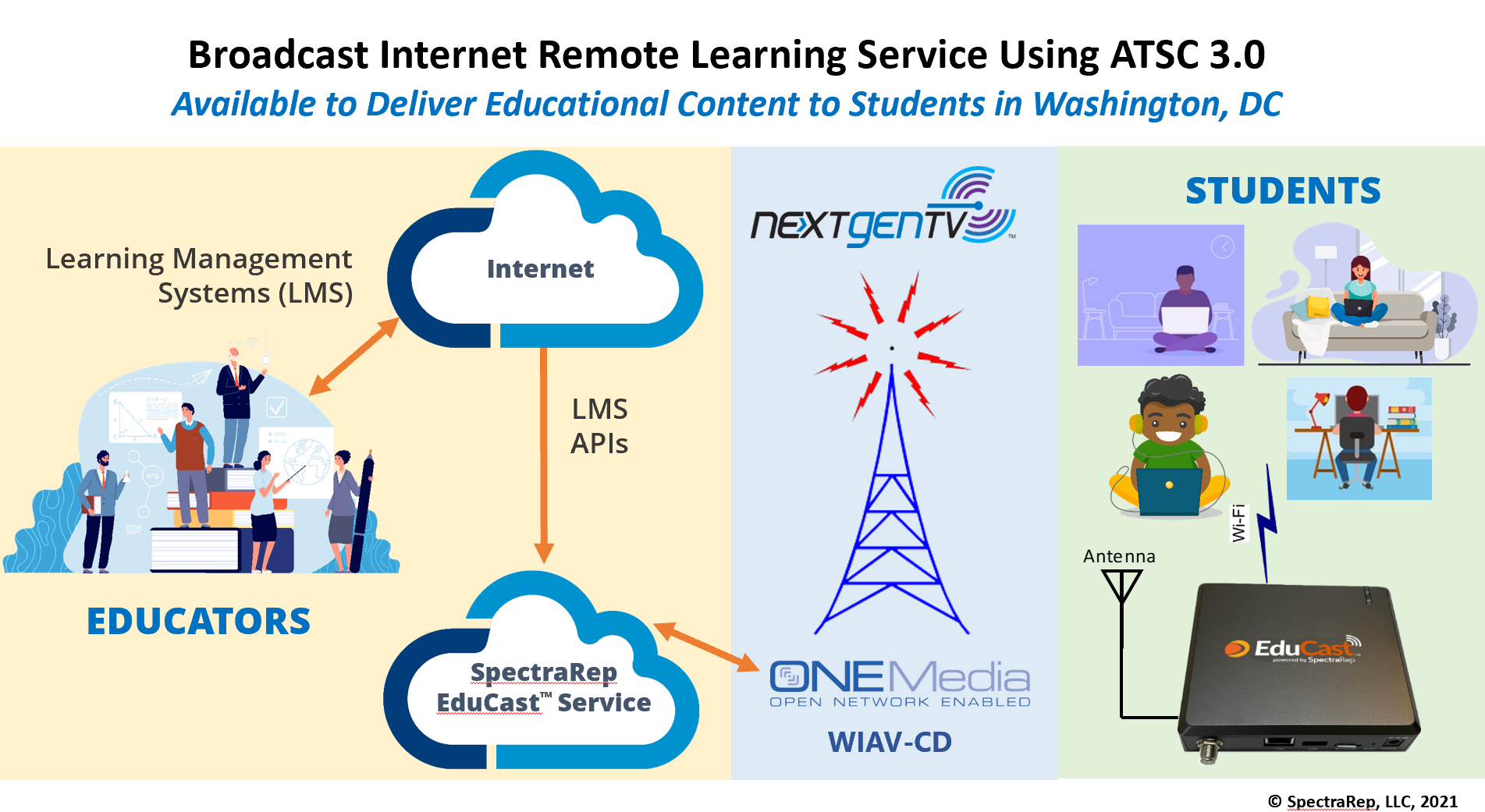NextGen TV: EduCast Remote Learning Service Launched in D.C.
SpectraRep’s EduCast broadcast remote learning service reaches the Washington D.C. market via NextGen TV broadcasts from Sinclair’s WIAV station

WASHINGTON, D.C.—In a development that highlights growing interest in using NextGen TV broadcasts for education, SpectraRep announced that its EduCast service has been successfully deployed in the Washington, DC area using ATSC 3.0 broadcasts from Sinclair’s WIAV station.
An example of the technical potential of using ATSC 3.0 for remote learning occured earlier this summer, when the NAB, the Howard University Middle School of Mathematics and Science, and Fincons Group demoed a remote learning system using NextGen TV broadcasts.
The EduCast deployment marks the first actual launch of a Broadcast Internet remote learning service in the nation to utilize NextGen TV broadcasters to deliver educational services. Using ATSC 3.0 broadcasts allows the services to reach students who have limited broadband access and makes it possible for educators to immediately evaluate and deploy Broadcast Internet for remote learning.
The launch of EduCast via ATSC 3.0 was done in partnership with ONE Media 3.0 and Sinclair Broadcast Group using its station, WIAV.
SpectraRep’s EduCast is the first and most widely deployed Broadcast Internet solution to meet the needs of K-12 and college learners who don't have access to sufficient broadband Internet services in their homes.
The Washington D.C. launch builds on that remote learning expertise by using broadcast Internet, also known as datacasting, to deliver IP-based content to users within the transmission footprint of the ATSC 3.0 broadcast signals.
“When the Covid-19 pandemic hit the country and students and teachers were sent home, we saw the negative impacts on remote learners without access to adequate broadband,” said Mark O’Brien, president and CTO of SpectraRep. “Issues like homework gaps and equity in education became even more acute, and we quickly realized we could help to bridge the digital divide through our technology and the enhanced advances offered by ATSC 3.0, in the same way we’ve supported public safety and law enforcement customers.”
Get the TV Tech Newsletter
The professional video industry's #1 source for news, trends and product and tech information. Sign up below.
The NextGen TV ATSC 3.0 standard for broadcasting offers higher data rates and more robust performance.
EduCast, a datacasting service, uses a portion of the digital television capacity to deliver a secure, wireless data network that safely delivers targeted assignments, course materials and classroom videos to students. With EduCast, educators are better able to reach their students and provide a more equitable remote learning environment, the company said.
“EduCast is operational and available in 12 states using the ATSC 1.0 transmission standard,” O’Brian said. “SpectraRep has procured and continues to deploy tens of thousands of in-home receivers, each capable of supporting multiple students in a household simultaneously. Now, with ATSC 3.0, we can directly support even more students faster and in a timeframe and manner that keeps them learning no matter what the new school year brings.”
“When the ATSC 3.0 standard was ratified, we knew it could dramatically improve our service offerings due to its native IP architecture, increased data capacity, and better reception characteristics,” added John McCoskey, SpectraRep’s COO. “Our goal was to enhance our services to operate using both ATSC 1.0 and ATSC 3.0 transmission systems and to provide stations and end users a simple, no-cost transition from one to the other. At the station that means just configuration changes and moving a few cables. The in-home receiver we chose and have deployed already supports both transmission standards.”
SpectraRep partnered with DigiCAP to develop an advanced in-home receiver capable of simultaneous operation using both ATSC 1.0 and 3.0 transmission.
“The challenge was to design a small in-home device that could receive, store, and serve educational content delivered by ATSC 1.0 and 3.0 broadcasters,” explained DigiCAP vice president and fellow, Joonyoung Park. “It also had to be manufactured inexpensively and be simple enough for students to self-install and operate. Despite the worldwide chip shortages and manufacturing hold ups caused by the pandemic, we were able to adapt our manufacturing pipeline to meet these challenges and deliver the badly needed devices that were intricately important to the overall success of the EduCast system.”
Educators access the EduCast service using their existing Learning Management System (LMS) and tools. They do not need to follow a separate workflow or take extra efforts to reach their students.
Students receive a customized package of content that includes only their own classes, lessons, and assignments that is based on their login credentials programmed in the in-home receiver, the company said. Educators can also target content to individual students.
In a student’s home, the DigiCAP receiver connects to a simple TV antenna that is used to receive the broadcast signal and the IP content it carries. The receiver establishes a Wi-Fi hotspot in the home that students connect to with their Chromebook, tablet, laptop, or smartphone. The receiver stores up to 128 GBytes of educator-curated content. This can include videos, presentation slides, worksheets, interactive documents, and images. Anything that can be saved as a file can be delivered.
For more details on SpectraRep’s EduCast Service, visit www.spectrarep.com.
George Winslow is the senior content producer for TV Tech. He has written about the television, media and technology industries for nearly 30 years for such publications as Broadcasting & Cable, Multichannel News and TV Tech. Over the years, he has edited a number of magazines, including Multichannel News International and World Screen, and moderated panels at such major industry events as NAB and MIP TV. He has published two books and dozens of encyclopedia articles on such subjects as the media, New York City history and economics.

